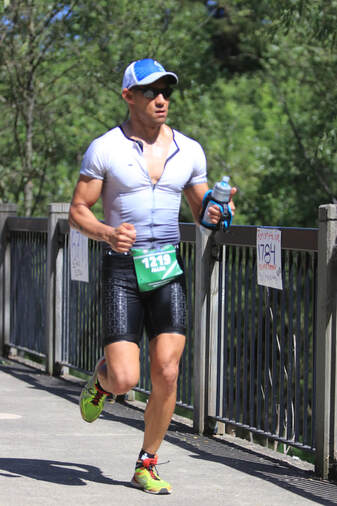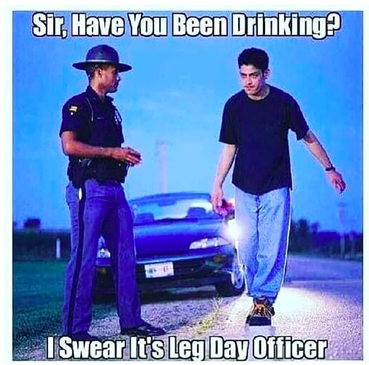|
Bottom line: If you have an injured limb and are unable to train as normal (or train at all), training the other side can still yield benefits of the injured side Question time….Let’s say you injure your left knee. What is the best strategy for your training plan? 1 Push through pain no matter how bad it is. Don’t change your training plan. Rest is for sissies 2 Continue to train the right knee, so long as it doesn’t further injure or provoke symptoms in the left 3 Stop training both legs because you don’t want you’re right leg to become too strong relative to your left and develop an asymmetry There is a “best” answer here and that answer is number 2. Answer number 1 is ridiculous, so we’ll put that one aside. Number 3 sounds compelling and while it wouldn’t necessarily be “wrong” to go that direction, there are several reasons why number 2 is better. Again, this is all based on the caveat that the training you do for the uninjured limb doesn’t put the injured limb at further risk of injury or delay healing. For example, let’s say you were doing some single leg activities on the uninjured leg, but each impact sent a “shock” through the injured leg. Your best bet is to either find different activities or delay training the uninjured limb until it can be done safely without provoking the injured limb. In the literature, the concept of training effects on one limb being felt on the opposite side limb is called cross education. And to the surprise of some, the evidence is quite clear that cross-education works. Unfortunately, what should be the standard of care (training the rest of the body at the highest level possible in a way that supports the healing process), is instead a novel concept to many. There are several reasons why cross-limb education is not promoted more. One is that the medical process is often siloed and sees the world with tunnel vision. For example, most orthopedic surgeons are going to just look at the injury and not even consider. That’s not meant to be critical, it’s just the nature of their job. They’re good at going into a damaged body part and making structural corrections using surgical techniques. They aren’t paid to tell you how to train. Similarly, most PT’s in a “traditional” outpatient setting aren’t getting paid to consider the opposite leg (and in some cases are actively discouraged from looking anyplace other than the site of the injury…Not their fault, that’s just the nature of the system in which they work). uninjured limb.
What does the evidence say?....A meta-analysis by Green (2018) reviewed 96 studies on cross education involving healthy young adults, healthy older adults and patients, finding an average strength gain via cross education of 18% in young adults, 15% in older adults, and 29% in a patient population. Although prior meta analyses had shown conflicting results on gender differences and upper versus lower limb effects, the studies compiled by in the Green meta-analysis revealed no significant differences. Overall, the average cross body transfer ranged from 48%-77% in the compiled studies, meaning that the immobilized limb experienced strength gains of 48%-77% of the trained limb. Again, this isn’t just one study on a homogenous group of subjects…this is 96 studies in a variety of populations. (Another interesting finding was that electrically stimulation of muscles appeared to have a greater cross-education effect than voluntary stimulation). WHY cross education works remains up for debate but most evidence points to neurological mechanisms as the primary factors. Per Cirer-Sastre (2017), “this owes to the fact that no significant vascular adaptations have been found, nor were any histological changes in hypertrophy levels, in enzyme concentration, in contractile protein composition alteration, in fiber type or in cross-sectional area.” In short, strength is function of the nervous system, and the effects of nervous system output are global, meaning not specific to any single body part. Although the evidence has been relatively settled that cross-education does exist via single sided training, HOW to facilitate cross-education is less clear although a meta-analysis of ten studies by Cirer-Sastre, “to optimize contralateral strength improvements, cross-training sessions should involve fast eccentric sets with moderate volumes and rest intervals. Finally, approaching this from a pragmatic standpoint, if you sustain an injury to a limb, you could continue training the other limbs and have three “good” limbs or you could stop training both the injured and non-injured arm/leg and have two “good” limbs. Which sounds better? The concern about developing asymmetries is logical, but overall is far overblown. As we know from the research, the cross-education effect will mitigate strength losses from inactivity by an injured limb. Further, even if cross-education did not exist, you’re better off having to bring one limb up to speed rather than losing strength in both sides have having two limbs to return to normal. Simply makes no sense why you would voluntarily weaken a perfectly healthy limb. Even if an asymmetry develops during a recovery period, its not as though you were going to hop right back into peak training after you get over the injury. You might as well give yourself the highest “baseline” with a strong, healthy limb rather than let both sides regress. REFERENCES Lara A. Green & David A. Gabriel (2018) The effect of unilateral training on contralateral limb strength in young, older, and patient populations: a meta-analysis of cross education, Physical Therapy Reviews, 23:4-5, 238-249, DOI: 10.1080/10833196.2018.1499272 Cirer-Sastre R, Beltrán-Garrido JV, Corbi F. Contralateral Effects After Unilateral Strength Training: A Meta-Analysis Comparing Training Loads. J Sports Sci Med. 2017;16(2):180–186. Published 2017 Jun 1.
0 Comments
I know the feeling. Been running along and then BAM…who just whacked the side of my knee with a baseball bat?? Oh, wait…there’s no one around…
Knee pain is one of the classic issues that can befuddle runners. The problem is that not all knee pain is created equal. Saying “knee pain” can mean any number of things, and quite often the problem is far away from the knee. Sure, we need to calm down the pain if we want to start moving normally, but long-term progress requires us to search a little deeper. The purpose of this guide is to help you as an athlete navigate what can seem like an unsolvable puzzle, especially when you’ve been trying to find a solution for weeks, months or even years.  “You’ll hurt your knees if you run.” This old yarn has been spun for decades…but is it true?? Conventional thinking has long believed that “running is bad for your knees,” largely based on anecdotal observation and blanket assumptions. Yes, runners are injured a lot (much of it self inflicted through poor training choices, not the inherent act of running). But does high prevalence of overall injury equate to chronic “bad knees”? A meta-analysis (aka, really big study looking at a bunch of other papers) from 2017 by Alentorn-Geli, et al, examined several studies encompassing over 100,000 runners of all levels and control groups of non-runners to see if any association existed between running and arthritis. Bottom line up front: Amateur runners (non-professionals) experience LOWER rates of hip and knee OA compared to runners who compete for money or people who don’t run at all. Among the amateur runners, the OA rate was 3.5% whereas more than 10% of the non-runners experienced OA, as did more than 13% of the professionals. (Also of note was that running for less than 15 years was associated with lower OA rates). Based on these findings from a large set of data, running actually could be good GOOD for your joints, when done below the professional level. This makes physiological sense when viewed through the lens of Wolff’s Law, which states that bone will remodel in response to the forces or demands placed upon it. If you expose bone to repeated stressors of running it will grow stronger along the lines of forces applied. But we also know that with any stressor applied to the body, any excess force beyond the body’s ability to adapt can lead to undesirable changes, such as injury or chronic strain. A subsequent 2018 study by Ponzio et al (thus not included in the 2017 meta analysis) on marathon runners of all levels found that age, family history and surgical history were predictive of hip or knee OA, but there was also NO significant risk associated with running duration, intensity, mileage, or the number of marathons completed. Additionally United States marathon runners in this sample experienced significantly lower OA rates (8.8%) as compared to the US average (17.9%). Do runners get hip and knee OA? Yes, of course. But so do people who don’t run at all…and those people seem to get MORE OA than amateur runners by a notable margin. Take home point: ALL types of people develop knee problems through the normal course of aging. Some happen to be runners, some don’t run. While intense training levels from the professional level seem to be related with increased OA signs, if we are to infer any causation from evidence, it would be that modest amounts of running could be protective against OA. Regardless, it would seem there’s enough evidence to cast significant doubt on the old suspicion that “running is bad for your knees.”  Let me tell you about our patient Ashley… Ashley came to see me just weeks after starting an exercise program. Having turned 30 the previous August, she felt a sense of urgency in her life. Single and childless, the proverbial biological clock loomed in her consciousness. Professionally, life was great in her teaching job. But she knew she needed to make changes to her lifestyle. Having been a casual smoker for years, the first step was to give up smoking and began exercising. Pizza and donuts also gave way to smoothies and salads. So firm was her commitment to change that she began this transformation in December, before the traditional “New Year’s Resolution” crowd. She found a welcoming home at the local Orange Theory and hired a personal trainer. She started craving the endorphin rush of the HIIT training and seeing the progress in her physique. But one day in January she felt an unwelcome twinge beneath her knee. A trip to the doctor confirmed it was a stress fracture, and she was “sentenced” to at least six weeks of limited weight bearing on her injured leg and an even longer time in a knee brace. Over the next several weeks, she was diligently committed to the plan, as an active participant in manual therapy to control pain and swelling, while incorporating strength and mobility training to recover the function she had lost in the weeks of wearing a brace and guarding against pain. But more important than recovering her function was recovering her confidence. Before each session on the treadmill, she required gentle reassurance of what she had already accomplished with ease in prior sessions. With each successful progression, her confidence and trust in her leg grew more robust. Thanks to quick healing, she was soon ready to return to Orange Theory. We had several talks about communicating with the coaches to find alternatives for jumping and running, which eased many of her concerns. Then before her first class back, I received a text from her sitting in the parking lot..”I’m scared :(“ And who in her situation wouldn’t be? If anything, I was proud of her for recognizing her fear and pausing before entering a situation where she didn’t feel comfortable. Fortunately, she only needed a couple reminders of the physical and mental strategies that had worked for her in the clinic. Within minutes, she made a successful return to class and was back on course to living the new life she had envisioned for herself. What can we learn from Ashley? Rehab is not just the physical. Strengthening the body is important, but callousing the mind is vital. Ashley regained her healthy lifestyle by confronting her fears and gaining strength through the daily victories she experienced both inside and outside of the clinic. If you need help reclaiming the active lifestyle that pain and injury have robbed from you, please reach out to Ventana Physiotherapy for a 30 minute Discovery Visit to discuss how we can best serve you. Dr. Allan Phillips Owner, Ventana Physiotherapy 520-306-8093 [email protected] www.ventanapt.physio |
AuthorAllan Phillips, PT, DPT is owner of Ventana Physiotherapy Archives
December 2023
Categories
All
|
2951 N. Swan Rd.
Suite 101, inside Bodywork at Onyx
Tucson, Arizona 85712
Call or Text: (520) 306-8093
[email protected]
Terms of Service (here)
Privacy Policy (here)
Medical disclaimer: All information on this website is intended for instruction and informational purposes only. The authors are not responsible for any harm or injury that may result. Significant injury risk is possible if you do not follow due diligence and seek suitable professional advice about your injury. No guarantees of specific results are expressly made or implied on this website.
Privacy Policy (here)
Medical disclaimer: All information on this website is intended for instruction and informational purposes only. The authors are not responsible for any harm or injury that may result. Significant injury risk is possible if you do not follow due diligence and seek suitable professional advice about your injury. No guarantees of specific results are expressly made or implied on this website.
Proudly powered by Weebly


 RSS Feed
RSS Feed